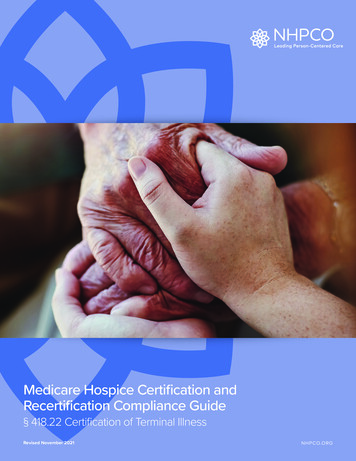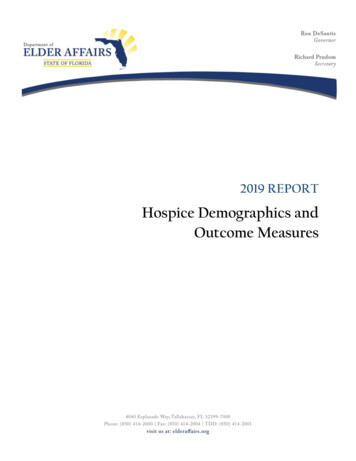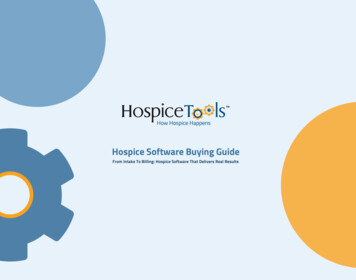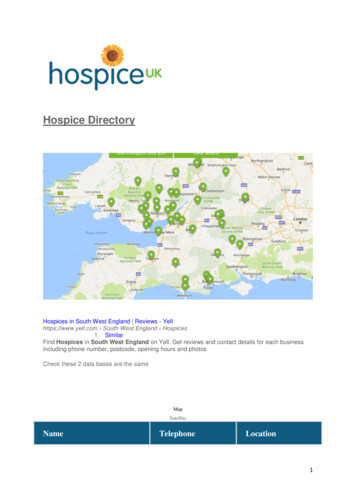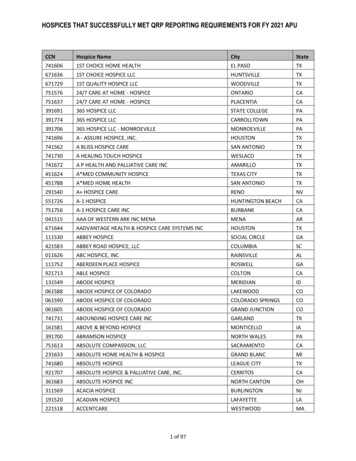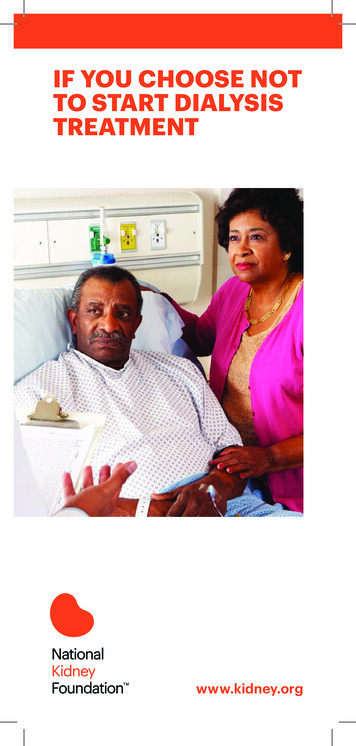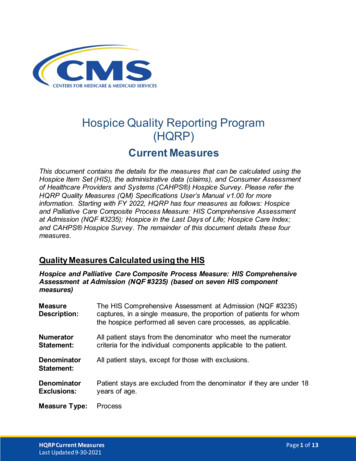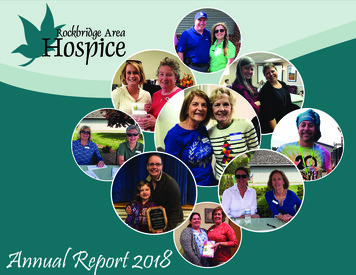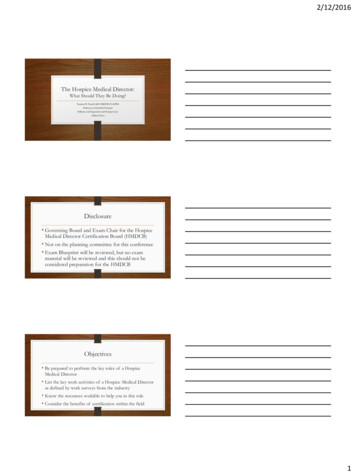
Transcription
2/12/2016The Hospice Medical Director:What Should They Be Doing?Tommie W. Farrell, MD HMDCB FAAHPMPathways at Hendrick HospitalPalliative and Supportive and Hospice CareAbilene TexasDisclosure Governing Board and Exam Chair for the HospiceMedical Director Certification Board (HMDCB) Not on the planning committee for this conference Exam Blueprint will be reviewed, but no exammaterial will be reviewed and this should not beconsidered preparation for the HMDCBObjectives Be prepared to perform the key roles of a HospiceMedical Director List the key work activities of a Hospice Medical Directoras defined by work surveys from the industry Know the resources available to help you in this role Consider the benefits of certification within the field1
2/12/2016For Hospice Administrators / Nurses What would you like from a Hospice MedicalDirector?For Hospice Medical Directors What roles would you like to participate in? Why do you do this job?HMD Roles Patient Care Nursing Responsiveness Face for Hospice Regulatory Compliance Others?2
2/12/2016History 1978: National Hospice Organization Formed, later evolves into theNational Hospice and Palliative Care Organization (NHPCO) 1982: Congress includes a provision to create a Medicare hospice benefitin the Tax Equity and Fiscal Responsibility Act of 1982, with a 1986sunset provision. 1984: JCAHO initiates hospice accreditation. 1986: The Medicare Hospice Benefit is made permanent by Congress andhospices are given a 10% increase in reimbursement rates. States are giventhe option of including hospice in their Medicaid programs. Hospice careis now available to terminally ill nursing home residents.History 1998: American Academy of Hospice and Palliative Medicine(AAHPM) Founded 1998: Institute of Medicine releases report – Approaching Death: ImprovingCare at the End of Life 1998: Care Beyond Cure: Physician Education in End-of-Life Care isreleased by the Annenberg Center for Health Sciences and theNational Hospice Foundation.History 2000: The Duke Institute on Care at the End of Life isestablished. 2006: The American Board of Medical Specialties (ABMS)recognizes hospice and palliative medicine as a medical specialty. 2007: The National Quality Forum releases A National Frameworkfor Palliative and Hospice Care Quality Measurement and Reporting.3
2/12/2016History 2008: ABMS and AOA board certification initiated 2008:the Medical Director Education Committee of theAAHPM, with support from the NHPCO, launched amultiphase research project to validate the need for andinterest in a certification program for physicians practicing inhospice (medical directors or staff physicians) intending tobecome hospice medical directors.History 2009: The Accreditation Council for Graduate MedicalEducation adds hospice and palliative medicine to its list ofaccredited programs. 2011: AAHPM's Medical Director Education Committeerecommended establishment of a separate 501(c)6certification organization to develop and oversee acertification to meet the needs of physicians providinghospice care.History 2012: an organizing board of directors for the Hospice Medical DirectorCertification Board (HMDCB) was appointed and began work onincorporation and development of the certification program. 2013: program development including an initial practice analysis studyleading to Blueprint of Essential HMD Work Practices 2014: last opportunity for physicians to take the ABMS Board for Hospiceand Palliative Medicine without completing a ACGME certifiedfellowship program4
2/12/2016History 2014: Institute of Medicine (IOM) releases the reportDying in America: Improving Quality and HonoringIndividual Preferences Near the End of LifeHMD Competencies Patient and Family CareMedical KnowledgeMedical Leadership and CommunicationProfessionalismSystems-Based PracticePatient and Family Care Oversee and manage: family meetingsgoals of caredo not resuscitate (DNR) orders/orders for life-sustaining treatmentconflict resolutionwithdrawal of life-sustaining therapiespalliative sedationmedication review5
2/12/2016Patient and Family Care Assess patient and family with regards to cultural and personal diversities Educate the patient and family (e.g., disease trajectory, prognosis, symptommanagement, impending death, and complication anticipation) Assess and document the patient’s decision-making capacity Serve as a patient advocate Facilitate legal surrogate’s role in decision makingPatient and Family Care Support the family through the moment of death Ensure provision of primary care to Hospice patients (e.g., when primaryphysician is not available) Recognize social problems experienced by hospice patients and their familiesand collaborate with the interdisciplinary group to assess and manage them Assess and resolve issues with family dynamics (e.g., coping styles,psychological defenses, and developmental stages)Medical Knowledge Assess and differentiate types of pain including total pain Assess and manage: acute and chronic painmedications for painnon-opioid medications for painnon-pain symptoms*non-pharmacologic measures for pain and non-pain symptoms (complementary andalternative therapies) disorders* (e.g., delirium, dementia, depression, and anxiety)6
2/12/2016Medical Knowledge Demonstrate knowledge of: the physical, emotional, spiritual, and psychosocial dimensions of caresettings where hospice and palliative care are providedpatient assessment and management across hospice care settingsaddiction, pseudo-addiction, opioid toxicity, and dependence and tolerancebrain death, persistent vegetative state, and minimally conscious statenormal and complex griefpediatric life-threatening conditionssigns and symptoms of impending deathvarious routes of medication deliverypalliative sedationMedical Knowledge Manage medical conditions commonly encountered in hospice careAssess and manage of risk associated with drug abuse, addiction and diversionIdentify indications for interventional symptom management, including radiation therapy*Formulate and certify prognosis for hospice patients by: Reviewing available clinical data* (e.g., comorbid and secondary conditions, medical findings, diseaseprogression, medications and treatment orders) Understanding the patient's and family's expectations and goals for care Demonstrate knowledge of, and recognize limitations of, evidence-based medicine inhospice careMedical Leadership and Communication Demonstrate interpersonal communication skills*Model empathic communication (e.g., expression of compassion)Communicate with referring and consultant clinicians about the care planFacilitate conflict resolution and 'service recovery'*Explain physician culture and behaviors to hospice staffEducate Hospice staff about communication with physiciansProvide ongoing education for Hospice staff7
2/12/2016Medical Leadership and Communication Provide education of the community at large Provide emotional support to staff around difficult decisions and care scenarios Communicate the mission of hospice to hospital administrators, clinicians, andcommunity at large Facilitate the interdisciplinary group process Demonstrate the ability to reflect on his/her personal leadership style and usedifferent styles to suit the situation and goals Demonstrate skill as a supervisor and mentorMedical Leadership and Communication Supervise team providers (e.g., physician and nurse practitioner) related to: certification and recertification*development of a plan of caresymptom managementclinical assessments and face-to-face encounterspharmacy and formulary managementperformance improvementfatigue and burnoutdocumentation of carebilling and codingProfessionalism Recognize and manage fatigue and burnout Practice active self-care Demonstrate boundaries with colleagues, patients, and families and helpinterdisciplinary group members do the same Recognize and accept responsibility for errors when appropriate Disclose medical errors in accord with institutional policies and professionalethics8
2/12/2016Professionalism Make recommendations to attending and consulting physicians(s) andcoordinate medical care Collaborate with other health professionals to coordinate the plan of care Demonstrate commitment to continuing professional development and lifelong learning Seek feedback and engage in the self-assessment processSystem-Based Practice Apply knowledge of ethics and law relatedto: informed consent confidentiality decision-making capacity for patient andsurrogate limits of surrogate decision-making truth-telling withholding/withdrawing life-sustainingtherapies* medical futility Apply knowledge of ethics and law relatedto: use of artificial hydration and nutrition*physician-aided dying (assisted suicide)euthanasiaprinciple of double effectorgan donationnurse-physician collaborationindications for referring to an ethics consultantconflicts of interestSystem-Based Practice Demonstrate knowledge of hospice regulation and reimbursement Utilize local coverage determinations and understand limitations* Participate in the process of: additional development requests (ADR)redetermination or reconsiderationtestifying to the Administrative Law Judgedifferentiate and respond to technical and medical denials9
2/12/2016System-Based Practice Participate in the following aspects of the survey process: the role of clinical documentation focused or targeted medical review of a Corrective Action Plan Ensure patient access to allied health professionals (e.g., speech therapist,nutritionist)System-Based Practice Comply with legal and regulatory issues surrounding opioid prescribing Comply with Medicare/Medicaid Hospice Benefit* (e.g., Conditions ofParticipation, requirements for certification, related/unrelated to terminaldiagnosis, and levels of hospice care) Perform pre-hospice consultation Ensure compliance with accreditation policies (e.g., The Joint Commission,CHAP)System-Based Practice Understand these elements of quality improvement (QI) in the hospicesetting: differentiate quality assurance and performance improvement* role of clinical indicators approach to data collection for quality review role of focused QI studies Assist in the design of clinically relevant quality-of-care outcome measures10
2/12/2016System-Based Practice Use data to demonstrate clinical, utilization, and financial outcomes of hospice care Demonstrate awareness of and adherence to patient safety standards Observe hospice policy (e.g., related to infection control, employee safety,emergency preparedness, harassment) Promote the role of the medical director as a member of the leadership team Develop strategies to manage barriers to utilization of medications (includingcontrolled drugs) in different clinical care settingsHMD Resources Hospice Medical Director Manual - http://aahpm.org/self-study/hmdmanual AAHPM Hospice Medical Director Conference AAHPM discussion forums - http://connect.aahpm.org/home Fast Facts - https://www.capc.org/fast-facts/HMD Resources Journal of Pain and Symptom Management and PC-FACs - ZzdWJzY3JpYmVySWQ9ODE5MzA5ODk4 Conditions of Participation - ation/CFCsAndCoPs/Hospice.html NHPCO Standards of Hospice Practice .php?file 555&view 42 Risk Evaluation and Mitigation Strategy (REMS) for Extended-Release and LongActing Opioids - http://aahpm.org/self-study/rems11
2/12/2016HMD Resources Others?Consider Certification www.hmdcb.org Reasons for the physician You Owe It to Yourself - professional recognition and credibilityImprove your opportunities for career advancement.Increase your professional marketability.Increased recognition and standards of the field.Connect with a network of HMDCB-certified peers.Will future regulatory agencies require this?Consider Certification Reasons for employers Create an environment of professionalism and a culture of retention.Minimize exposure to compliance issues, including fraud and abuse charges.Build a strong team committed to quality standards of care.Differentiate your hospice from competitors.Demonstrate to patients and families that you attract committed healthcareprofessionals. Will future regulatory agencies require this?12
2/12/2016Other Thoughts and 3
certification organization to develop and oversee a certification to meet the needs of physicians providing hospice care. History 2012: an organizing board of directors for the Hospice Medical Director Certification Board (HMDCB) was appointed and began work on incorporation and development of the certification program.


